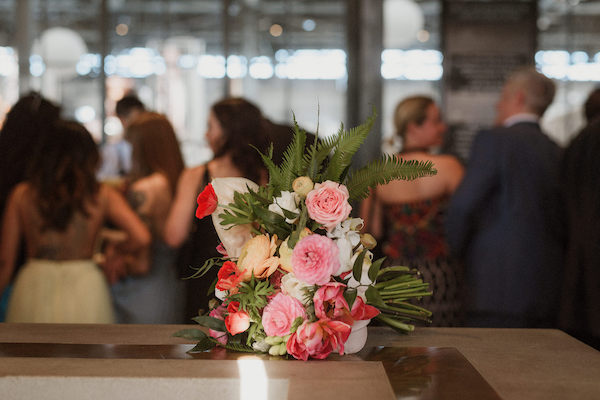Ever since I got married, my favorite part about going to other people’s weddings is that I didn’t have to plan any of it. Don’t get me wrong, I enjoyed every moment leading up to my wedding, and the day went off without a hitch. But making it happen was basically like taking on a second job — except instead of earning money, I was spending it.
Why am I saying all of this? Because wedding planning is a serious undertaking. If you’re starting to get your ducks in a row, you may be feeling a bit overwhelmed. You might not even know where to start. This guide is going to change all of that. Keep reading for tips that will save your sanity and keep you organized right up until you say, “I do.”
Create a Wedding Email Address
Setting up a wedding-specific email address is the first step to staying organized during wedding planning. Here’s why: Your personal inbox is a great place for emails to get lost or missed, and there’s just so much potential for cross-contamination that can put a snag in your plans. Creating a dedicated email address keeps all your wedding-related communications in one place and gives you and your partner equal access to all those details.
If you’ve created a wedding website, there may be a feature that allows you to easily set up an email address associated with the site. It’s also super easy to create a unique GMail account. The most important thing is that you remember your login information! Consider creating a username you can use beyond your wedding, such as TheSmiths25 or SmithFamily25. That way, you can use your custom email for future family vacations, kids’ activities, schools, and anything else that requires email communication!
Use Digital Planning Tools
Speaking of Gmail, Google offers a whole suite of digital tools that make it easy to organize your wedding planning details. But it’s not the only option. Here’s a quick overview of some of the top digital planning tools for planning your wedding:
- Google Docs and Sheets: Use these collaborative tools for creating and sharing documents and spreadsheets that offer real-time editing, easy sharing with partners and planners, and accessibility across all your devices. These tools are perfect for the guest list, budget, and more.
- Pinterest: Leverage the visual discovery platform to gather and organize your wedding inspiration, from the decor to the attire and themes. This can be especially useful when it’s time to communicate your vision to your vendors!
- Trello: Your inner project planner will love using this management tool to track your wedding tasks and progress. You can even go so far as to assign responsibilities and set deadlines through the platform.
- AllSeated: This event planning platform brings your vision to life by allowing you to create seating arrangements and venue layouts, manage guest lists, and collaborate with vendors. It also offers 3D floor plans.
- Canva: Create fun graphics and designs for custom wedding invitations, save-the-dates, and other stationery. Canva is great for beginners and pros alike, with user-friendly templates, a drag-and-drop interface, and extensive design elements.
- Joy App: If you’re looking for an all-in-one platform, this app enables users to create custom wedding websites and digital invitations and manage their guest list with real-time RSVP tracking.

Create a Planning Timeline and Schedule
Once you’ve created your wedding email address and decided on the planning tools you will use, it’s time to make your wedding planning schedule. This will help you stay focused on a few details at a time and give you a reference point any time you start to feel overwhelmed.
Here’s a general breakdown of what you should include in your timeline:
12 months before the wedding
- Set Your Budget: Determine your overall budget and discuss contributions from all parties involved.
- Draft a Guest List: Create a preliminary guest list to estimate the number of attendees.
- Hire a Wedding Planner: If desired, engage a professional to assist with planning and coordination.
- Choose a Venue and Date: Select and book your ceremony and reception venues to secure your preferred date.
11 months before
- Select Key Vendors: Research and book essential vendors such as caterers, photographers, videographers, and entertainment.
- Establish a Wedding Website: Create a site to share details and updates with guests.
- Engage Your Wedding Party: Invite friends and family to be part of your bridal party.
10 months before
- Shop for Attire: Begin searching for your wedding dress and attire for the bridal party.
- Register for Gifts: Set up your wedding registry to guide guests on gift selections.
- Plan Engagement Photos: Schedule an engagement session to capture this special time and consider using the photos for save-the-dates.
9 months before
- Send Save the Dates: Notify guests of your wedding date and location.
- Book Accommodations: Reserve hotel room blocks for out-of-town guests.
- Research Transportation: Look into guest and bridal party transportation options on the wedding day.
8 months before
- Hire Additional Vendors: Secure florists, bakers, and other specialty services.
- Plan Honeymoon: Start organizing your post-wedding getaway, including travel arrangements and accommodations.
- Finalize Your Guest List: Confirm addresses and contact information for all invitees.
6–7 months before
- Order Invitations: Choose and order your wedding invitations and other stationery.
- Schedule Tastings: Arrange tastings with your caterer and baker to finalize menus.
- Plan Ceremony Details: Work with your officiant to outline the ceremony structure and any readings.
4–5 months before
- Purchase Wedding Bands: Select and order rings for the ceremony.
- Arrange Attire Fittings: Schedule fittings for the bride, groom, and bridal party.
- Prepare for Pre-Wedding Events: If asked, assist your in-laws in planning the rehearsal dinner, and if someone has offered to host a bridal shower, provide a guest list.
3 months before
- Mail Invitations: Address envelopes and send out wedding invitations to guests.
- Confirm Vendor Details: Review contracts and confirm details with all vendors.
- Obtain a Marriage License: Research requirements and apply for your marriage license.
2 months before
- Create a Day-of Timeline: Develop a detailed schedule for the wedding day, including vendor arrival times and event sequences.
- Finalize Seating Chart: Determine guest seating arrangements for the reception.
- Write Vows: If personalizing vows, begin drafting them.
1 month before
- Confirm RSVPs: Reach out to guests who have yet to respond.
- Final Payments: Settle any outstanding balances with vendors.
- Prepare for the Honeymoon: Confirm travel plans and pack for your trip.
Week of the wedding
- Delegate Tasks: Assign day-of responsibilities to trusted individuals.
- Attend the Rehearsal: Conduct a ceremony rehearsal with the bridal party and officiant.
- Relax and Enjoy: Take time to rest and savor the moments leading up to your wedding day.
Create a Detailed Budget

One primary source of wedding planning stress is the budget. Understanding and staying within your financial limitations is imperative to sticking to your budget. Be realistic when establishing your budget by considering your top priorities and determining any external contributions from family members.
From there, you can allocate your funds, reserving about 5% for unexpected expenses, such as hidden fees or service charges in your vendor contracts. Track your spending after every decision and transaction to always have an up-to-date budget. Our final tip for staying on budget? Don’t fall prey to outside influence (especially on social media); focus on what’s important to you as a couple, and forget about anyone else’s expectations.
Delegate, Delegate, Delegate
It can be tempting to be the bride who does it all, and if you truly can handle it all alone, go for it. However, for the rest of us regular ladies, delegation is key to staying organized (and sane) during wedding planning.
Start by identifying people in your circle that you trust to get the job done, then start delegating tasks that don’t need to be on your plate, like:
- Researching vendors to help you narrow down your options and make a decision.
- Coordinating transportation for yourself and your guests to ensure arrivals and departures stay on schedule.
- Overseeing decorations set up so you can focus on personal preparations.
- Handling vendor payments – which can help prevent last-minute financial snafus. This is also where budgeting comes in very handy.
- Managing the wedding day timeline to keep events on schedule and running smoothly.
- Coordinating post-wedding cleanup – giving you the luxury of being able to leave your wedding without worrying.
Schedule Regular Check-ins
Even if you’re the most organized bride, details can easily get lost in the shuffle of daily life. Scheduling regular check-ins with your partner, vendors, and planning team is key to staying organized and on track. These check-ins allow you to align priorities, address any questions, and keep things running smoothly.
First, set up a recurring time to check in with your partner, whether weekly or bi-weekly. These mini-meetings help you stay on the same page about major elements like your budget, guest list, and decor. Use the time to talk through any concerns, celebrate your progress, and divide upcoming tasks.
For vendors, regular communication keeps the process professional and ensures everyone is clear on expectations. Schedule calls or meetings at key milestones to confirm timelines, review contracts, or finalize details. For any friends and family involved in the planning, a quick video call or coffee chat can help everyone feel included and ensure their contributions align with your vision.

Create a Day-of Timeline
When your wedding day rolls around, you want it to go off without a hitch — especially after staying organized in the months leading up to the big day! A well-structured day-of timeline is the backbone of a seamless wedding celebration. It orchestrates every detail, ensuring that events flow smoothly and everyone involved knows their roles and timing.
Start by identifying the key moments of your wedding day—the ceremony, cocktail hour, and reception—and determining their start times and durations to establish the framework for your schedule. Then, coordinate with your hair and makeup artists to set realistic start and end times for preparations. Don’t forget to allocate time for first-look portraits before your ceremony!
Outline your ceremony events and share the schedule with your officiant and wedding party, then plan the transition to the reception. If your ceremony and reception are at different venues, account for travel time for all your guests. Add buffer time between events, then map out the order and timing of your reception activities (great guidelines here). Finally, distribute your finalized timeline to vendors, your wedding party, and key family members to ensure everyone is aligned.
Now You’re Ready
Staying organized while planning a wedding may seem like a lot of work, but it’s worth every second. By putting in the time to determine all the details and keep track of your budget and progress, you can ensure that your wedding happens exactly how you envision it. Happy planning!
All blog images via Helena and Laurent Photography

